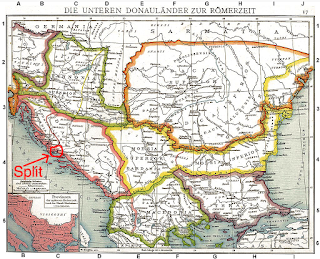This is Roman grave monument of Servius Ennius Fuscus, soldier of the VIII Cohort Voluntariorum, originally from Cemenelum (modern Cimiez, Nice), who died aged 38 after 19 years' service; he is shown in military gear with his wife Fulvia Vitalis at his side. 1st century AD, Split
It looks pretty normal and ordinary at the first glance, but...
During the first century AD, Split was part of the Roman province of Illyricum, which comprised of Dalmatia and Pannonia, as is the mention by Velleius Pareculus of Gaius Vibius Postumus as the military commander of Dalmatia under Germanicus in 9 AD
Now what is interesting about this roman funerary stela from Split is the hand gesture performed by Servius and possibly his wife too (not clear from the image).
Here is the detail
Does it look familiar?
Here it is on the painting "The Takovo Uprising", painted in 1888 by renowned Serbian painter Paja Jovanović. Three finger salute by Serbs starting the uprising against the Turks...
Here is the detail
The reason Serbs on this painting are using this salute is because it symbolised trinity. Here is the same salute on old christian images. Pic from "The Evil Eye", by Frederick Thomas Elworthy, [1895]
Officially the three finger gesture was first used by Saint Meletius, Archbishop of Antioch, in 381 during the Second Ecumenical Council...
But what if this hand gesture was used even earlier, but was just first time documented in the 4th century AD?
We know that the same gesture called Mano Pantea was used by Pagans in the Balkans at the same time...
We know that the same gesture called Mano Pantea was used by Pagans in the Balkans at the same time...
This was in fact the main symbol of Sabazios (Ancient Greek: Σαβάζιος, romanized: Sabázios, modern pronunciation Savázios) the sky father god of the Phrygians and Thracians...
Back to the Roman funerary monument from Split. It is possible that Servius and his wife are pagan worshipers of Sabazios and are using the three finger sign to show their devotion to this god...
But here is something interesting. Servius is also holding a scroll. This is a fourth century painting of St. Paul. Paul's dress, the scroll in his hands, and the container with more scrolls at his feet, all identify Paul as a philosopher, a teacher.
Was Servius a teacher too?
And if he was a teacher, what was he teaching in Illyricum in the first century AD? Maybe Christianity. There are Slavic legends which say that St Paul converted Slavs in Illyricum in the 1st century AD...Was Servius one of the converts?
More about these legends in my post "St Paul among the Slavs"
That indeed there could have been Christian converts in the 1st century AD Illyricum is indicated by the finds from Židovar archaeological site in Northern Serbia. A beautifully silver box decorated with a cross, was found in the layers dated to the period 2nd century BC - 1st century AD.
That this was indeed the find from the 1st century AD, is the fact that the box contained two bronze rings with fish, Good Shepard and palm branch, all early Christian symbols.
You can read more about this in my post "Church on the Threshing floor"
And so, back to our Servius from Split.
The only thing that would definitely rule out that Servius was a possible Christian convert would be if his monument dated to very early first century AD. But it seems that it dates to the period between 70AD and 130AD which means that he could have well been a Christian convert and that this is why his gravestone looks the way it does...
It could just be nothing...But it could be an early Christian monument...Who knows...














No comments:
Post a Comment